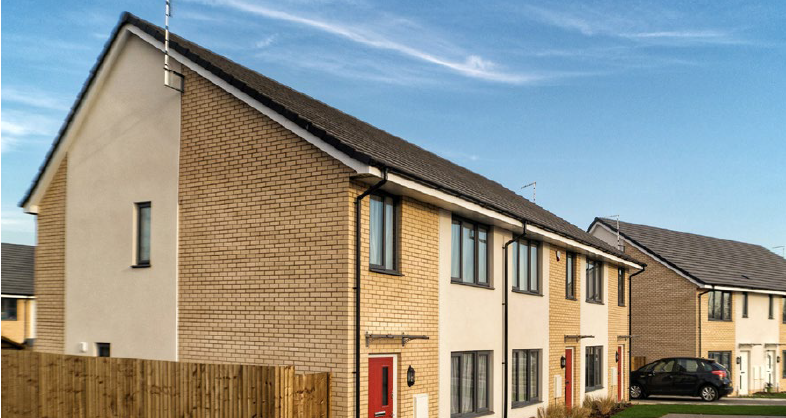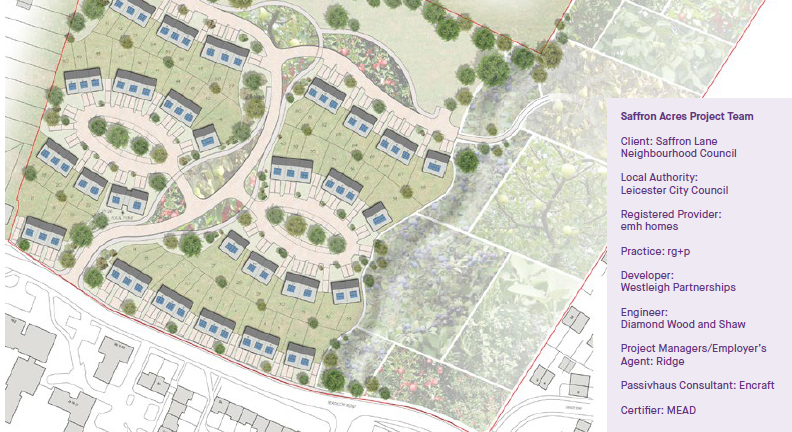Saffron Acres, Leicester, the UK’S largest Passivhaus residential development
Contents |
[edit] Introduction
In the heart of Leicester, the UK’s largest Passivhaus accredited affordable housing scheme, Saffron Acres, was completed last year. Tahir Caratella ACIAT is an architectural Technologist at rg+p, the practice appointed to design the development. Here, he explains how this community-led project has revitalised a derelict urban landscape and pioneered a way for similar projects across the UK.
[edit] The brief
The Saffron Estate was a 13.2 acre disused local authority allotment site on the southern edge of Leicester city. Saffron Lane Neighbourhood Council (SNLC) approached Leicester City Council to provide the land for a development of affordable homes and a permaculture farm as part of a community-led initiative. Together, the two councils partnered with registered provider, emh homes; developer, Westleigh Partnerships and architects, rg+p to deliver the scheme.
rg+p’s brief was to design a development of homes to not only achieve high environmental standards but also bring the community together by integrating the existing permaculture farm and community garden on the adjacent land.
[edit] The design
The £7m Saffron Acres development comprises a mix of 68 homes and apartments, from one bedroom apartments to four bedroom houses, including eight to wheelchair standard. Each of the properties has high levels of insulation, minimised building surface to volume area, controlled ventilation and increased glazing to deliberately designed south-facing living rooms. In the surrounding environment, total integration with the permaculture farm was ensured through the provision of a flower meadow, rejuvenation of field ponds, reinstating of hedgerows and fruit tree planting.
‘We worked to BIM level 2 to quickly develop initial design ideas and then a site plan and house types within just a few weeks’, explains Tahir. ‘We then created detailed street scenes and visualisations to take into account the specific considerations to achieve Passivhaus accreditation. For instance, all properties face south to maximise warmth from the sun, whereas on the north side, where the air is cooler, we allocated extra space for the mechanical ventilation heat recovery (MHVR) units and air ducts.
‘These designs were prepared closely with our Passivhaus consultants, Encraft to ensure total compliance and also with Westleigh as all the homes were constructed using Westframe PassiPlus, the developer’s bespoke, sustainable timber frames and panels. We used OSB as the airtight barrier and Westleigh ensured there was good micro-management on site to avoid air membranes or OSB being punctured by site operatives’.
[edit] Technical data
- Each home at Saffron Acres was air tested and individually accredited to Passivhaus standards. The anticipated annual running costs for heating were just £13 per home. Ongoing monitoring is being undertaken by DeMontfort University under a grant from Westleigh Developments Ltd.
- MHVR units are Airflow Duplexvent DV 40 and have summer bypass function
- Westframe PassiPlus timber framing achieves U-values as low as 0.1W/m²K
- Windows achieve U-values of 0.5 W/m²K
- Primary energy ranges from 82-98 kWh/m²/a
- Heating demand ranges from 14-20 kWh/m²/a
- Air changes range from 0.22-0.6 pascals
- Heating load ranges from 8-10 W/m²
- PHPP% of the year overheating ranges from 0-3%, with most at 0%
- Heat source(s): High efficient gas combi boilers and advanced heating controls serving towel rail rads in WC’s and bathrooms only.
[edit] The outcomes
Saffron Acres is a true pioneer in the field of sustainable affordable housing and has acted as a flagship scheme for Leicester. All homes are now occupied and feedback from residents has been wholly positive. The SNLC community garden has been well used, with residents growing fruit and vegetables, even producing their own brand jam and chutney which is sold in Midlands Co-op stores.
In the professional community, Saffron Acres has been a finalist in ten regional and national awards, winning five. Judges from the Royal Institution of Chartered Surveyors (RICS), where the scheme won the East Midlands Residential Project of the Year, commented: ‘This outstanding residential development encapsulates all that is good in modern site and space planning in terms of style as well as both community creation and internal, flexible design. All whilst achieving outstanding energy efficiency through its Passivhaus status and clever surface water management.’
Tahir concluded: ‘The scale of Saffron Acres is what makes it so innovative and unique. Passivhaus standards are used in affordable housing throughout the UK, but none to this scale. A great deal of consideration went into creating a successful scheme that will benefit the residents of today and the future; we’re exceptionally proud of what we’ve collectively achieved.’
Tahir Caratella has a BSc (Hons) in Architectural Design Technology and Production from DeMontfort University and is currently working towards MCIAT.
This article originally appeared in CIAT's Architectural Technology Journal, Issue 125, Spring 2018.
--CIAT
[edit] Find out more
[edit] Related articles on Designing Buildings Wiki
Featured articles and news
Latest Build UK Building Safety Regime explainer published
Key elements in one short, now updated document.
UKGBC launch the UK Climate Resilience Roadmap
First guidance of its kind on direct climate impacts for the built environment and how it can adapt.
CLC Health, Safety and Wellbeing Strategy 2025
Launched by the Minister for Industry to look at fatalities on site, improving mental health and other issues.
One of the most impressive Victorian architects. Book review.
Common Assessment Standard now with building safety
New CAS update now includes mandatory building safety questions.
RTPI leader to become new CIOB Chief Executive Officer
Dr Victoria Hills MRTPI, FICE to take over after Caroline Gumble’s departure.
Social and affordable housing, a long term plan for delivery
The “Delivering a Decade of Renewal for Social and Affordable Housing” strategy sets out future path.
A change to adoptive architecture
Effects of global weather warming on architectural detailing, material choice and human interaction.
The proposed publicly owned and backed subsidiary of Homes England, to facilitate new homes.
How big is the problem and what can we do to mitigate the effects?
Overheating guidance and tools for building designers
A number of cool guides to help with the heat.
The UK's Modern Industrial Strategy: A 10 year plan
Previous consultation criticism, current key elements and general support with some persisting reservations.
Building Safety Regulator reforms
New roles, new staff and a new fast track service pave the way for a single construction regulator.
Architectural Technologist CPDs and Communications
CIAT CPD… and how you can do it!
Cooling centres and cool spaces
Managing extreme heat in cities by directing the public to places for heat stress relief and water sources.
Winter gardens: A brief history and warm variations
Extending the season with glass in different forms and terms.
Restoring Great Yarmouth's Winter Gardens
Transforming one of the least sustainable constructions imaginable.

























